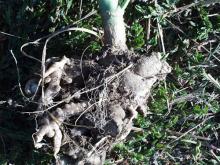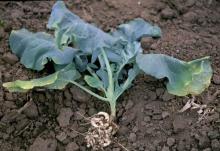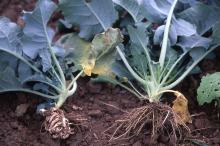See:
Seed Crop, Crucifers (Brassica, Eruca, and Raphanus spp.) - Clubroot
By C. M. Ocamb
Cause The disease is caused by Plasmodiophora brassicae, a fungus-like microorganism that can survive in soil 18 years or more after an infected crop. This obligate parasite has been considered a primitive fungus or slime mold, but is now classified as a member of the group of protists named Cercozoa. This pathogen is cosmopolitan, likely affects all members of Brassicaceae family. The microorganism that causes clubroot occurs worldwide and possibly infects plants in the rose, poppy, and grass families. However, these plants rarely show typical symptoms of the disease. Viable spores of Plasmodiophora brassicae were detected on canola, pea and wheat seeds as well as on potato tubers harvested from clubroot-infested fields in Alberta, Canada.
Plasmodiophora brassicae survives as resting spores in soil; these resting spores are produced inside infected plant tissues and are released into the soil as the infected plant material breaks down. Motile spores known as zoospores form inside resting spores, and zoospores are released in response to the presence of cruciferous roots in the vicinity. Zoospores swim to root hairs, where the primary infection occurs. Once inside the root hair, a plasmodium forms, which is a multinucleate protoplast (an amoeba-like form that lacks a rigid cell wall). The plasmodium cleaves into secondary zoospores. These secondary zoospores can penetrate and infect adjacent cells, spreading disease further into the root by breeching the cortical tissues of roots. Secondary zoospores may infect root hairs on the same root or on nearby roots of the same plant or those of neighboring plants. Additional plasmodia develop after successful infection by secondary zoospores, which ultimately result in gall formation and clubbing of roots. Eventually, secondary plasmodia inside roots transform into the resting spore stage. Resting spores may survive upwards of 10 years or longer and exhibit a half-life that ranges from three to six years. Resting spores can be spread through any means that moves soil: wind and water, footwear and equipment, and via infected transplants.
Soils that are cool, wet (70% to 80% water-holding capacity) and acidic favor the pathogen. Zoospore movement and infection is promoted by soil moisture levels above 50% soil water-holding capacity. Spore germination and infection of root hairs is inhibited by the presence of calcium and an alkaline pH, although calcium is critical for this pathogen's reproduction and growth. Heavy rains, flooding, and irrigation water run-off can move resting spores with the movement of soil, especially on sloping lands.
There are races of the pathogen that infect or cause more severe disease in certain crucifer species. It has been observed by OSU that brassicas and radish plants can be infected but asymptomatic, and resting spores were observed in inside asymptomatic root portions, suggesting that pathogen population could increase even with the use of highly resistant varieties.
Clubroot survival through composting is dependent upon not only temperature but also moisture levels. If there are dry pockets (<40% moisture) in hot composting, clubroot spores have a high probability of surviving under those conditions. Incubation of compost at 60% moisture and 122°F for 7 days or 24 hours at 140°F have been shown to prevent clubroot survival.
Symptoms The distinctive symptom is abnormally large roots-fine roots, secondary roots, the taproot, storage roots, or even on the underground stem. Roots develop clubs (swellings) that can be up to 6 inches wide. The largest clubs usually are just below the soil surface on the larger roots. Affected seedlings will not show any root swellings until about 3 weeks after infection. When susceptible plants are attacked in the seedling stage, they can die. When plants are attacked at a later stage, the disease rarely kills, but roots that are severely distorted have a reduced capacity to absorb minerals and water from soil. Affected plants wilt in hot weather but partly recover at night until the disease affects a larger portion of the root system, after which wilting becomes irreversible. As a consequence of major root infections, top growth may be stunted, yellowish, and likely to prematurely bolt or to wilt in hot weather. Severe infections can result in lodging of the plant or possible death. But even with extensive root clubbing, top growth may be nearly normal, depending on environmental conditions and cultural practices.
Sampling Because the pathogen cannot be cultured in the laboratory, traditional testing of soil for P. brassicae has been based on plant bioassays (soil baiting). The OSU Plant Clinic currently offers a molecular test for a common clubroot race in Oregon that can be used on plant tissue; research by OSU shows that current soil testing is unreliable due to chemical inhibitors in western Oregon soils.
Cultural control
- The variety, Ore. CR-1, is resistant to some strains of the fungus.
- Early infection of seedlings can result in severe symptoms; so for transplant production, it is important to use only uninfected seedbeds and clean transplant media, trays, and equipment.
- Do not lime seedbeds or transplant-growing media heavily. It may mask the disease, which could flare up once seedlings are transplanted to a soil of lower pH.
- Long rotations (three years or longer) help prevent a pathogen buildup and reduce disease.
- Control wild mustards and other weedy brassicas if they are a problem during rotations.
- Rotating into soybean, corn, and clover may decrease clubroot levels in subsequent Brassica crops.
- Never allow drainage water or soil from an infested field to enter an irrigation source. Spores are moved easily in irrigation water.
- Work in pathogen-free fields before moving people and machinery into infested fields. Thoroughly clean soil from machinery and equipment before moving from an infested field to a clean one.
- If growing susceptible crops in suspect or infested fields, incorporate enough finely ground limestone the year before planting to raise the soil pH above 7 (7.3 to 7.5). Use lime applications that increase soil pH as well as level of soil calcium. Thoroughly mix lime into the soil to maximize potential disease control. Lime inhibits disease development, but will not prevent a disease outbreak if the spore load in the soil is sufficiently high. Different soil types vary considerably in their response to efforts to alter the pH with lime. Therefore, measure the initial soil pH, follow Soil Moisture Potential (SMP) test recommendations, and monitor the changes after application. Periodically monitor the pH in subsequent years to determine the stability of the change.
- If planting in a suspect or infected field, incorporating hydrated lime (1,500 lb/A) at least 6 weeks before planting, whether pH is neutral or alkaline, gives additional disease control.
- The form of nitrogen fertilizer can also influence disease. Using calcium nitrate may result in less disease compared to ammonium sulfate or urea.
- If clubroot occurs, hilling-up plants can encourage production of adventitious roots, which may result in a better yield.
- Soil solarization with plastic can weaken resting spores.
Chemical control
- Preplant soil treatment with Blocker 4F (Group 14). PCNB does not control clubroot completely but reduces the number of clubs and secondary root rots so that the crop is nearly normal size. 12-hr reentry.
- For transplanted or direct-seeded fields, use 5.62 gal/A (55 fl oz/1,000 ft row).
- Use 3 pints/100 gal for transplant solutions. Recommended only for commercial growers.
- Omega F (Group 29) at 6.45 fl oz/100 gallons as transplant drench or 2.6 pints/A as soil incorporation with a minimum band width of 9 inches. Product may cause plant stunting or delay and shorten harvest. Preharvest interval is 50 days. 12-hr reentry, except for high exposure activities (i.e., hand weeding) that have a 48-hr reentry.
References Dixon, G.R. 2007. Clubroot. In: Compendium of Brassica Diseases. Rimmer, S.R., Shattuck, V.I., and Buchwaldt, L. (eds.). St. Paul, MN: APS Press; p. 25-28.
Dixon, G.R. 2009. Plasmodiophora brassicae in its environment. J. Plant Growth Regul. 28:212-228.
Fayolle, L., Noble, R., Coventry, E., Aime, S., and Alabouvette, C. 2006. Eradication of Plasmodiophora brassicae during composting of wastes. Plant Pathology 55:553-558.
Kageyama, K., and Asano, T. 2009. Life cycle of Plasmodiophora brassicae. J. Plant Growth Regul. 28:203-211.
Kowata-Dresch, L.S., and May-De Mio, L.L. 2012. Clubroot management of highly infested soils. Crop Protection 35:47-52.
Lahlali, R., and Peng, G. 2014. Suppression of clubroot by Clonostachys rosea via antibiosis and induced host resistance. Plant Pathology 63:447-455.
Myers, D.F., and Campbell, R.N. 1985. Lime and the control of clubroot of crucifers: Effect of pH, calcium, magnesium, and their interactions. Phytopatholgy 75:670-673.
Myers, D.F., Campell, R.N., and Greathead, A.S. 1983. Thermal inactivation of Plasmodiophora brassicae Woron. and its attempted control by solarization in the Salinas Valley of California. Crop Protect. 2(3):325-333.
Yang, X.-X., Huang, X.-Q., Wu, W.-X., Xiang, Y.-J., Du, L., Zhang, L., and Liu, Y. 2020. Effects of different rotation patterns on the occurrence of clubroot disease and diversity of rhizosphere microbes. J. Integrative Ag. 19(9):2265-2273.





